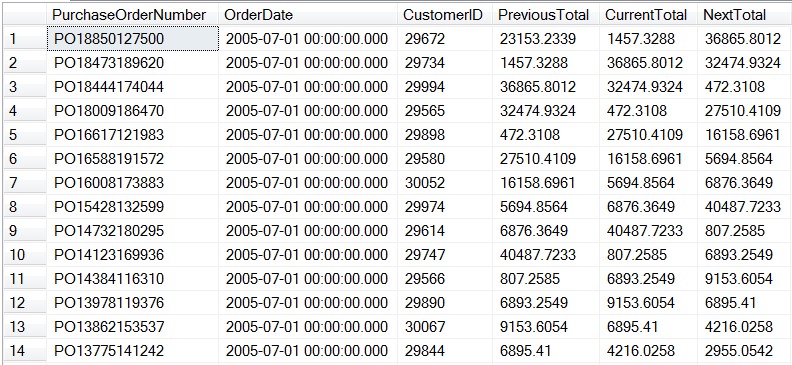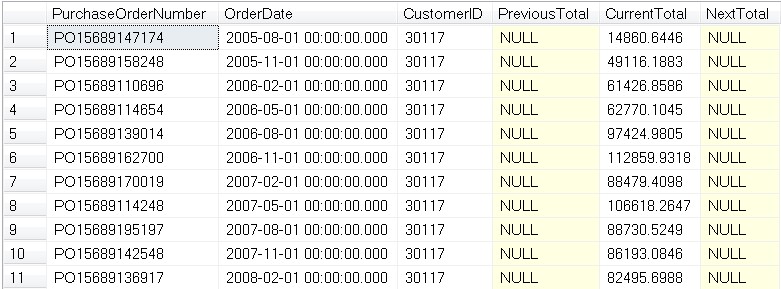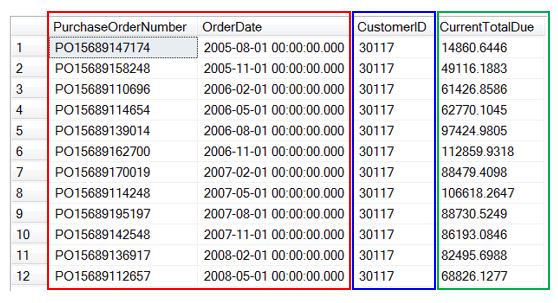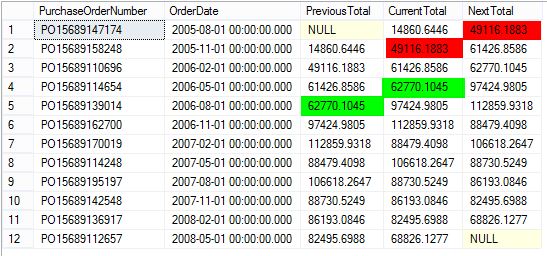I have been finding more and more uses for the OVER statement recently and I figured it was about time I did a blog post on it. The OVER statement captures a window of data that can be aggregated and included with the details of the original result set. There are a set of window functions that can be applied to the OVER statement to generate row numbers, ranking values, averaging, getting previous values and next values in a set. This idea of getting the previous and next values, in a set of data, is a problem that I just ran into recently. This blog post will describe the usage of LAG and LEAD analytical functions. LAG and LEAD are two new Analytical Window Functions that were introduced in SQL Server 2012.
Recently I was tasked with calculating the difference between two values, however the values existed in different rows. My first thought was a self-join on the table and compare the two results. Using Adventure Works 2012, I ran the following query and the results are shown.
SELECT soh.PurchaseOrderNumber , soh.OrderDate , soh.CustomerID , PreviousTotal = soh1.TotalDue , CurrentTotal = soh.TotalDue , NextTotal = soh2.TotalDue FROM Sales.SalesOrderHeader soh JOIN Sales.SalesOrderHeader soh1 ON soh1.SalesOrderID = soh.SalesOrderID - 1 JOIN Sales.SalesOrderHeader soh2 ON soh2.SalesOrderID = soh.SalesOrderID + 1; |
This result set shows the previous and next record values for the TotalDue column. This got me 1/2 way to what was needed to perform the difference calculations. I needed the results for a given customer rather than all customers. I updated the query to allow for a customer ID to be passed into the query and the results are shown.
DECLARE @CustomerID int = 30117; SELECT soh.PurchaseOrderNumber , soh.OrderDate , soh.CustomerID , PreviousTotal = soh1.TotalDue , CurrentTotal = soh.TotalDue , NextTotal = soh2.TotalDue FROM Sales.SalesOrderHeader soh LEFT JOIN Sales.SalesOrderHeader soh1 ON soh1.SalesOrderID = soh.SalesOrderID - 1 AND soh1.CustomerID = soh.CustomerID LEFT JOIN Sales.SalesOrderHeader soh2 ON soh2.SalesOrderID = soh.SalesOrderID + 1 AND soh2.CustomerID = soh.CustomerID WHERE soh.CustomerID = @CustomerID; |
This is was a problem. Being that I was using the SalesOrderID to perform the self-joins on the tables, and the Customer’s records were not in sequential order, I was not getting any of the previous and next records.
LEAD()/LAG() OVER (PARTITION BY)
Instead of going down the path of craziness, I decided to eliminate the use of the self-referencing joins and opted to use the OVER clause with LEAD and LAG to solve the problem. Using the following query and output we can explain the LEAD(), LAG(), OVER (PARTITION BY) statements.
DECLARE @CustomerID int = 30117; SELECT PurchaseOrderNumber , OrderDate , CustomerID , CurrentTotalDue = TotalDue FROM Sales.SalesOrderHeader soh WHERE soh.CustomerID = @CustomerID; |
In the blue box is the CustomerID column, this is the column we want to Partition by.
In the red box is the PurchaseOrderNumber and OrderDate columns, these columns we want to order the results of the window.
In the green box is the CurrentTotalDue, this is the column that we will pass to the LEAD and LAG window functions.
I updated the query to use the LEAD and LAG window functions and the results are shown. The red highlights show the results of the LEAD function and the green highlights show the results of the LAG function.
DECLARE @CustomerID int = 30117; SELECT PurchaseOrderNumber , OrderDate , PreviousTotal = LAG(TotalDue) OVER (PARTITION BY CustomerID ORDER BY OrderDate , PurchaseOrderNumber) , CurrentTotal = TotalDue , NextTotal = LEAD(TotalDue) OVER (PARTITION BY CustomerID ORDER BY OrderDate , PurchaseOrderNumber) FROM Sales.SalesOrderHeader soh WHERE soh.CustomerID = @CustomerID; |
As you can see the syntax for writing a query to use these LEAD and LAG are not overly complex. In a future blog post I will dive deeper into using the OVER statement.



